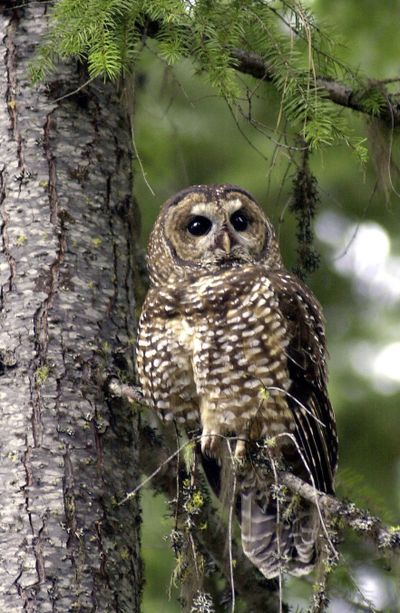Feds reduce spotted owl habitat
23 percent more forest unprotected

GRANTS PASS, Ore. – The Bush administration has decided that the northern spotted owl can get by with less old growth forest habitat as it struggles to get off the threatened species list.
The U.S. Fish and Wildlife Service said Tuesday it would cut by 23 percent the federal forest land designated as critical habitat for the owl in Washington, Oregon and Northern California. Critical habitat is a requirement of the Endangered Species Act and offers increased, though not absolute, protections against logging.
Meanwhile, owl numbers are dropping by 4 percent a year from a combination of habitat lost to logging and wildfire and an invasion of its habitat by the barred owl, a more aggressive East Coast cousin that migrated across Canada and has been working its way south.
Conservation groups said the critical habitat designation and a new plan for restoring owl populations were contrary to the advice of leading scientists and crafted to fulfill a Bush administration promise to the timber industry to increase logging.
Both the plan and the habitat designation appear certain to be headed for court.
“This is a parting gift from the Bush administration to its timber friends,” said Kristen Boyles, an attorney with Earthjustice in Seattle, a public interest environmental law firm that has been in the thick of legal battles over the owl for two decades. “It flies in the face of the science that says we need to protect more habitat, not less.”
The timber industry was not happy, either. Tom Partin, president of the American Forest Resources Council in Portland, said the recovery plan and critical habitat would make it more difficult to thin overgrown forests to reduce the risks to wildlife and to promote the old-growth characteristics the owls favor.
“After almost 20 years of relying on a static regulatory approach which has led to continual inaction and further decline of the owl, it is clear we should be using active management to improve the health of our forests and the spotted owl,” Partin said in a statement. “Unfortunately, this designation doubles down on a patently absurd approach.”
The spotted owl was declared a threatened species in 1990, primarily because of heavy logging in old growth forests. Lawsuits from conservation groups led to a reduction of more than 80 percent in logging on federal lands, causing economic pain in the region, particularly in small logging towns.
Working with the timber industry under a lawsuit settlement, the Bush administration has been trying to increase logging levels but has been stymied by court rulings.
Both the final recovery plan and the first draft of the critical habitat were flunked by independent scientists who reviewed them, primarily because they failed to protect enough habitat.
Fish and Wildlife Service spokeswoman Joan Jewett said the 5.3 million acres designated as critical owl habitat were chosen to coincide with the recommendations of the new recovery plan.
The recovery plan and the critical habitat designation open the doors for the U.S. Bureau of Land Management to begin a sharp increase in logging in old growth forests in Western Oregon, said Dominick DellaSala, who served on the team of scientists that was disbanded in the course of producing the recovery plan.
Jewett said 382,000 acres of Bureau of Land Management forests will no longer be designated as critical habitat – about a quarter of the total reduction of 1.6 million acres.